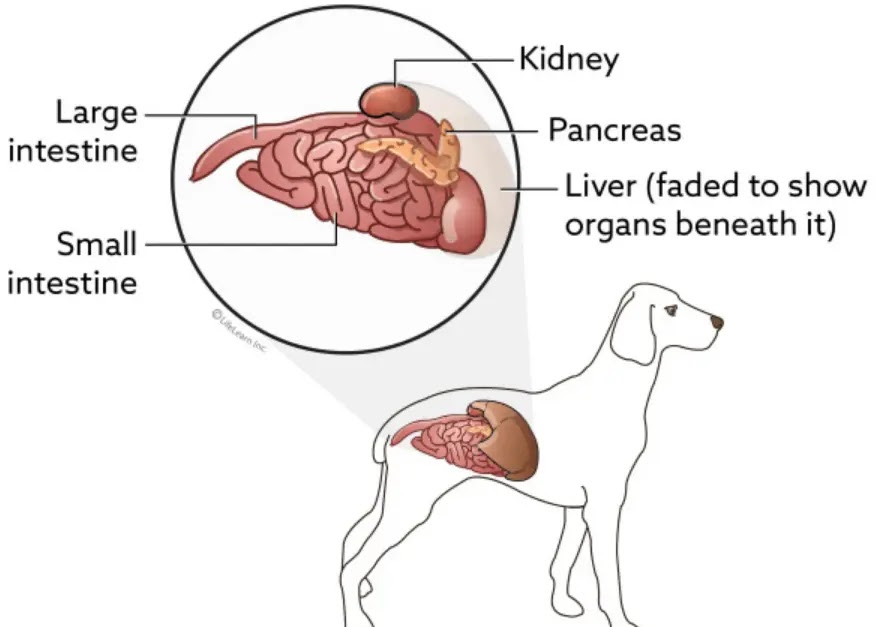Intestinal tumors, including intestinal cancer in dogs, develop due to abnormal proliferation and dysregulated replication of cells along the intestinal tract, encompassing both the small and large intestines. The small intestine comprises three distinct regions: the duodenum, jejunum, and ileum, while the large intestine consists of the cecum, colon, and rectum. Intestinal tumors commonly arise from the cells of the inner lining or the surrounding muscle of the intestine.
Intestinal tumors can be categorized as benign (non-cancerous) or malignant (cancerous). Malignant tumors are invasive and prone to metastasize (spread to other areas of the body). The majority of intestinal tumors fall under the malignant category, raising concerns about intestinal cancer in dogs and its impact on pets.
In dogs, three main types of intestinal tumors are observed: lymphoma, adenocarcinoma, and leiomyosarcoma. Lymphomas can occur anywhere along the intestinal tract, while adenocarcinomas are more commonly found in the large intestine, and leiomyosarcomas in the small intestine.
In cats, lymphoma is the most prevalent intestinal tumor, frequently affecting the small intestine. The next common type is adenocarcinoma, which mainly occurs in the large intestine, followed by mast cell tumors and leiomyosarcomas. Other types of intestinal tumors in both cats and dogs include leiomyomas, gastrointestinal stromal tumors (GISTs), plasmacytomas, adenomas, adenomatous polyps, carcinoids, and osteosarcomas. Polyps are more likely to be found in the duodenum (upper small intestine) in cats and the colon or rectum in dogs, and in dogs, they can transform into cancerous growths.
Digestive tract tumors, although uncommon, can have differing distributions in dogs and cats, with the majority of intestinal tumors in dogs occurring in the large intestine, while in cats, they are more commonly found in the small intestine.
Causes of Intestinal Tumors and Intestinal Cancer in Dogs
Determining the specific cause of intestinal cancer in dogs or any other tumor or cancer is challenging, as very few cases have a single known cause. Most instances seem to be influenced by a complex combination of risk factors, including environmental and genetic, or hereditary factors. In the case of intestinal tumors and intestinal cancer in dogs, age, sex, and breed are considered potential risk factors.
Similar to many cancers, the incidence of intestinal cancer in dogs increases with age. These tumors are more likely to occur in middle-aged to older dogs, usually between 6 and 9 years of age, and older cats, typically between 10 and 12 years old. Some tumors, such as leiomyomas, are more commonly found in very old dogs, with an average age of 16 years. Male pets generally face a higher risk than females, both for benign and malignant tumors. Also, read about Dogs getting skin cancer from the sun.
Certain breeds exhibit a predisposition to specific intestinal cancers, indicating the presence of specific genetic predispositions. For instance, in dogs, large breeds like German Shepherds tend to develop leiomyomas and leiomyosarcomas (both smooth muscle tumors). Adenocarcinomas are more commonly observed in German Shepherds, Collies, Boxers, Doberman Pinschers, Shar-Peis, Poodles, and West Highland White Terriers. German Shepherds and Collies are more prone to rectal polyps. Mast cell tumors are more common in Maltese and other miniature breeds. Additionally, tumors of the colon and rectum are more prevalent in Boxers, German Shepherds, Poodles, Great Danes, and Spaniels.
"Certain breeds exhibit a predisposition to specific intestinal cancers, indicating the presence of specific genetic predispositions."
In cats, the Siamese breed has a significantly higher likelihood of developing intestinal cancer compared to other breeds. The incidence of adenocarcinoma in Siamese cats can be up to 8 times greater than in other breeds. In fact, 70% of small intestinal adenocarcinomas in cats occur in Siamese cats. Siamese cats may also face an increased risk of intestinal lymphoma and intestinal polyps.
Signs of Intestinal Tumors and Cancer in Dogs
The signs of intestinal tumors can vary depending on the tumor's location, size, metastasis, and its associated effects on the body. Pet owners should remain vigilant and recognize the symptoms of intestinal cancer in dogs to ensure early detection and prompt treatment.
If your pet has a tumor in the small intestine, you may notice intermittent vomiting, reduced appetite, lethargy, and gradual weight loss. Vomit may appear blood-tinged or have a "coffee grounds" appearance, particularly with tumors of the upper small intestine (e.g., duodenum), which can cause bleeding due to ulceration. Bleeding from tumors anywhere along the small intestine can lead to blackish stools. Chronic bleeding may result in anemia, characterized by paleness of the gums due to low circulating red blood cells. You may also observe intestinal rumbling or gurgling noises, along with increased frequency of gas passing.
"The signs of intestinal tumors can vary depending on the tumor's location, size, metastasis, and its associated effects on the body."
If your pet has a tumor in the large intestine, you may notice bleeding from the anus, blood in the stool, and difficulty in passing stools. Chronic straining can sometimes lead to rectal prolapse, where the rectal lining protrudes through the anus. Stools may also become narrow and ribbon-like in appearance.
When the tumor is located at the juncture of the small and large intestine, your pet may exhibit a combination of signs associated with both small and large intestinal tumors. While diarrhea is not common, it can occur with tumors in both the small and large intestine. In some cases, fluid build-up in the abdomen can cause distention.
Pets with intestinal leiomyomas or leiomyosarcomas may experience lower than normal blood glucose levels (hypoglycemia), a type of paraneoplastic syndrome where substances released by cancer cells affect other organs' functioning. Signs of low blood glucose include restlessness, weakness, trembling, disorientation, and seizures. Another paraneoplastic syndrome associated with leiomyomas and leiomyosarcomas is tumor-associated nephrogenic diabetes insipidus, which causes excessive drinking and urination. Lymphoma and intestinal adenocarcinoma can also cause a paraneoplastic syndrome, namely hypercalcemia (high blood calcium), leading to excessive drinking and urination.
Diagnosis and Progression of Intestinal Cancer in Dogs
Diagnosing intestinal cancer in dogs typically involves a thorough examination and a series of tests. Your veterinarian may suspect intestinal cancer if your older dog displays poor body condition and signs of gastrointestinal upset. The findings during a physical examination may vary, with the possibility of finding a mass or distended, painful areas in the small intestine upon palpation of your pet's abdomen. Enlarged lymph nodes and certain organs, such as the liver, may also be detected, along with abdominal swelling. A mass may even be identified during a rectal exam.
To confirm the diagnosis, your veterinarian will perform blood tests, urinalysis, imaging tests, endoscopy, and a biopsy. Bloodwork and urinalysis can help identify changes associated with paraneoplastic syndromes. Radiographs (X-rays) may reveal the presence of a mass in the abdomen, and specialized imaging, such as a barium swallow, may detect ulceration in the intestine, reduced intestinal movement, or intestinal obstruction. Ultrasound is also useful, especially for examining the layers of the intestinal wall and obtaining an ultrasound-guided fine needle or core needle biopsy.
The biopsy procedure involves taking a small needle with a syringe to suction a sample of cells directly from the tumor and placing them on a slide for examination under a microscope by a veterinary pathologist.
Endoscopy, which uses a thin tube with a light and tiny camera at the end to visualize the intestine and obtain tissue samples, can be valuable in diagnosing tumors in most areas of the intestine. Biopsy samples can also be collected during endoscopy. However, if these samples are inconclusive, a surgical biopsy may be necessary to obtain an accurate diagnosis. Surgical biopsies can be performed via laparoscopy, a procedure using a laparoscope, or laparotomy, a surgery that involves opening the abdomen. Biopsy samples are examined by a veterinary pathologist using histopathology to identify the cancer type and predict its behavior. For rectal tumors, cells can be collected during a rectal exam.
The progression of intestinal cancer in dogs varies depending on the type of tumor and its impact on the body. Some tumors grow slowly, while others exhibit rapid growth. Without treatment, both benign and malignant tumors continue to grow, leading to complications in intestinal function, and an increased risk of ulceration or intestinal obstruction. In some cases, ulcerative tumors may cause perforation of the intestine, resulting in the leakage of intestinal contents into the abdomen, leading to a life-threatening infection.
As most intestinal tumors in dogs are malignant, they often metastasize to other areas of the body, including nearby lymph nodes, liver, lungs, and other organs, as well as the inner lining of the abdomen. Given the likelihood of metastasis, staging to assess potential spread to other locations is highly recommended. This may involve bloodwork, urinalysis, lung X-rays, and possibly an abdominal ultrasound. In some instances, more advanced imaging techniques like computed tomography (CT) scans or magnetic resonance imaging (MRI) may be utilized. If any lymph nodes appear enlarged or abnormal, further sampling may be performed to confirm the presence of metastasis.
Treatment Options for Intestinal Cancer in Dogs
The treatment approach for intestinal tumors, including intestinal cancer in dogs, depends on the type of tumor and the extent of its growth and spread. In most cases, surgery remains the preferred treatment option. Surgical removal of tumors that have metastasized primarily aims to alleviate symptoms and improve the pet's quality of life. In such cases, the long-term outlook is often limited, with surgery providing only a few months of relief before metastatic growth becomes problematic or the tumor regrows. In some instances, chemotherapy or radiation therapy may follow surgery. For instance, radiation therapy may be recommended for adenocarcinomas of the colon. With most intestinal tumors, surgery is the treatment of choice.
Intestinal lymphoma in dogs and cats can present as localized masses in one location or diffuse thickening of the intestinal wall. While surgery is advised when possible to alleviate cancer-related signs, lymphoma is typically treated with chemotherapy, regardless of tumor removal. Sometimes, chemotherapy is the preferred treatment approach for intestinal lymphoma in dogs and cats. Radiation therapy may also be recommended in some cases. In cases of muscle tumors, removing the tumor can resolve the signs of paraneoplastic syndromes.
Understanding intestinal tumors, including intestinal cancer in dogs, and their impact on our beloved pets is vital for early detection and effective treatment. Recognizing the signs and risk factors associated with these tumors empowers pet owners to seek veterinary care promptly, potentially improving their pets' prognosis. Although the outlook may vary based on tumor type, stage, and other health conditions, consulting a veterinarian or veterinary oncologist is crucial to devising the best plan of care for each individual pet.
Thank you for reading, and I hope this article has provided valuable insights for you and your furry companions.


